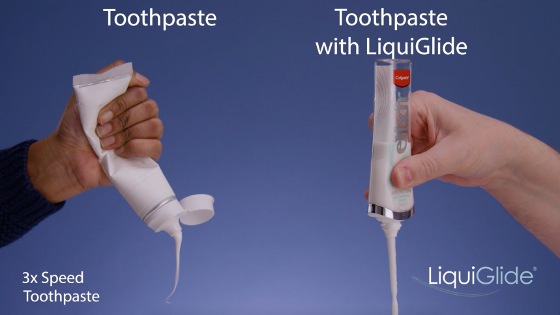 |
| May 11, 2021 | Volume 17 Issue 18 |
Designfax weekly eMagazine
Archives
Partners
Manufacturing Center
Product Spotlight
Modern Applications News
Metalworking Ideas For
Today's Job Shops
Tooling and Production
Strategies for large
metalworking plants
Nonstick coating for liquids goes commercial -- toothpaste stuck in tube may be thing of the past

A coating developed at MIT back in 2009 that virtually eliminates friction between solids and liquids has finally reached prime time -- and may be coming soon to products near you. LiquiGlide is a liquid-impregnated coating that acts as a slippery barrier between a surface and a viscous liquid. Applied inside a toothpaste tube, for instance, the coating clings permanently to its sides, while allowing the toothpaste to glide off completely -- with no residue.
LiquiGlide is now an MIT spinoff company and recently announced a $13.5M funding round and new partnerships with Colgate and the Mibelle Group. This brings the total amount raised by the company to $50M.
Invented at MIT by co-founders Dave Smith and Professor Kripa Varanasi, the company's first-of-its-kind patented technology removes friction, allowing thick, slow-moving liquids to flow with ease. The company first captivated imaginations worldwide in 2015 when it debuted a popular video that showed a new world of possibilities in packaging and beyond.
By eliminating friction, LiquiGlide has made previously impossible advancements in packaging, manufacturing, and medical devices a reality via safe and sustainable solutions that meet rigorous safety and regulatory standards.
How it works
LiquiGlide was originally developed while Smith worked on his graduate research in Varanasi's research group. Smith and Varanasi were interested in preventing ice buildup on airplane surfaces and methane hydrate buildup in oil and gas pipelines.
Some initial work was on superhydrophobic surfaces, which trap pockets of air and naturally repel water, but both researchers found that these surfaces don't, in fact, shed every bit of liquid. During phase transitions -- when vapor turns to liquid, for instance -- water droplets condense within microscopic gaps on surfaces and steadily accumulate. This leads to loss of anti-icing properties of the surface. "Something that is nonwetting to macroscopic drops does not remain nonwetting for microscopic drops," Varanasi said.
Inspired by the work of researcher David Quere, of ESPCI in Paris, on slippery "hemisolid-hemiliquid" surfaces, Varanasi and Smith invented permanently wet "liquid-impregnated surfaces" -- coatings that don't have such microscopic gaps. The coatings consist of textured solid material that traps a liquid lubricant through capillary and intermolecular forces. The coating wicks through the textured solid surface, clinging permanently under the product, allowing the product to slide off the surface easily; other materials can't enter the gaps or displace the coating. "One can say that it's a self-lubricating surface," Varanasi said.
In short, the LiquiGlide stays clinging to the inside surface of a bottle, while the product is released as needed in full.
Mixing and matching the materials, however, is a complicated process, Varanasi said. Liquid components of the coating, for instance, must be compatible with the chemical and physical properties of the sticky product, and generally immiscible. The solid material must form a textured structure while adhering to the container. Additionally, the coating can't spoil the contents: Foodstuffs, for instance, require safe, edible materials, such as plants and insoluble fibers.
To help choose ingredients, Smith and Varanasi developed the basic scientific principles and algorithms that calculate how the liquid and solid coating materials and the product, as well as the geometry of the surface structures, will all interact to find the optimal "recipe."
Having researched materials for hundreds of different viscous liquids over the years -- from peanut butter to crude oil to blood -- LiquiGlide also has a database of optimal ingredients for its algorithms to pull from when customizing recipes. "Given any new product you want LiquiGlide for, we can zero in on a solution that meets all requirements necessary," Varanasi said.
For manufacturers, LiquiGlide can also provide solutions to reduce friction in tanks, funnels, and hoppers.
Coming soon to a product near you
Consumers will soon be able to experience the difference LiquiGlide makes in the way they experience the products they use every day. For consumers in Europe, Colgate has just introduced a transformational, clear, PET, recyclable toothpaste package, developed in partnership with LiquiGlide, that allows toothpaste to dispense much more easily.
As part of LiquiGlide's partnership with the Mibelle Group, a leading Swiss consumer, cosmetics, and pharmaceutical products manufacturer, its technology is working to eliminate manufacturing waste. Using LiquiGlide's CleanTanX™ technology, the Mibelle Group has reduced the yield loss in its toothpaste manufacturing tanks up to 99% and seen significant savings in wash water, energy, and labor. Today, the partnership is expanding to other product lines.
In addition, the company has announced that it is partnering with leading industrial designer Yves Béhar and his design firm, fuseproject, to create elegant, no-waste, sustainable packaging for a line of health and beauty products under LiquiGlide's EveryDrop™ label. According to Béhar, "There is an opportunity here for design to leverage new technologies that can completely transform the way we think about the cyclical system of "zero waste" -- from product design to disposal -- to drive responsible consumption.
LiquiGlide's benefits extend beyond consumer products. The company is also focused on critically important applications of its technology in the biomedical domain, including the prevention of clogging, reduction of device-related infection, and the enhanced production and delivery of viscous drugs and biologics.
These partnerships, along with rapidly increasing consumer demand for more sustainable goods, underscore the vast opportunity ahead for LiquiGlide. The company nearly doubled its team in 2020 as it prepared to expand its technology into more applications. As part of its growth, LiquiGlide added veteran executives from the packaging and biotech sectors.
Learn more at liquiglide.com.
Source: LiquiGlide
Published May 2021
Rate this article
View our terms of use and privacy policy
